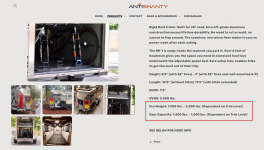Yes, most trailers list GVWR as the sum of their axle ratings. The axles
tend to be the weakest spot as far as weight carrying capacity goes, so manufacturers just default to that rating.
If the axles/suspension were to be significantly overbuilt, then manufacturers would have to get into frame capabilities, braking capabilities, and all kinds of other technical details that they don't want to bother with. They would also - potentially - assume legal liability for the rating, vs. simply being able to shove it on the axle manufacturer.
The only instance I can think of where the GVWR is different than what the suspension is rated for, is
Roam Resillient. They rate their suspension at 13,000lbs, but the GVWR is set at 9,000lbs. This suggests that the suspension is not the weakest link, and that they've done the engineering work across all their components to actually understand what can handle what. That's very rare in the trailer business.
As for the run of the mill trailers, they are often a crapshoot. Here's an example from my 2022 2108FBS Winnebago:
In the years leading up to about the 2021 model year (or even into early 2022), this trailer came with dual 3500lb axles and had a GVWR of 7000lbs. Weighing in at about 4400lbs dry, it had a relatively massive cargo capacity.
At some point in 2019-2021~ish, a series of the axles used on this trailer started failing. Rather than fixing the issues and using different axles, Winnebago went in a different route: they lowered the GVWR of the trailer, and the trailer manufacturer started putting different rating stickers on the same axles. The 3500lb axles now started coming with a sticker that says 3000lb. As far as I know, it's the same exact axle, but now rated lower. The 7000lb GVWR also went down, all the way to 5500lb. Nothing else changed.
We know (from the prior years) that the frame, brakes, and everything else can handle 7000lb GVWR, because there were no issues with these components. The axles were questionable, and got their rating dropped. Why is the trailer suddenly rated 500lbs
under the total axle capacity? The only reason I can come up with is that Winnebago is simply covering their ******, so they don't have to pay out on potential warranty repairs or lawsuits. IMO this is a sleazy move to pull, but not a surprising one.
My trailer was manufactured in August of 2022. I have paperwork (including the dealer's ad) that shows it as having 7000lb GVWR, and stickers on the trailer itself that show 5500lb. A circus all around.



